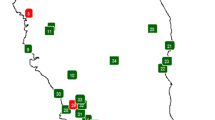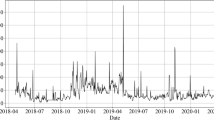Abstract
Malaysia has experienced several haze events since the 1980s as a consequence of the transboundary movement of air pollutants emitted from forest fires and open burning activities. Hazy episodes can result from local activities and be categorized as “localized haze”. General probability distributions (i.e., gamma and log-normal) were chosen to analyze the PM10 concentrations data at two different types of locations in Malaysia: industrial (Johor Bahru and Nilai) and residential (Kota Kinabalu and Kuantan). These areas were chosen based on their frequently high PM10 concentration readings. The best models representing the areas were chosen based on their performance indicator values. The best distributions provided the probability of exceedances and the return period between the actual and predicted concentrations based on the threshold limit given by the Malaysian Ambient Air Quality Guidelines (24-h average of 150 μg/m3) for PM10 concentrations. The short-term prediction for PM10 exceedances in 14 days was obtained using the autoregressive model.
Similar content being viewed by others
References
Abas, M. R., Oros, D. R., & Simoneit, B. R. T. (2004). Biomass burning as the main source of organic aerosol particulate matter in Malaysia during haze episodes. Chemosphere, 55, 1089–1095.
Abdel-Aziz, A., & Frey, H. C. (2003). Development of hourly probabilistic utility NOx emission inventories using time series techniques: part I—univariate approach. Atmospheric Environment, 37, 5379–5389.
Afroz, R., Hassan, M. N., & Ibrahim, N. A. (2003). Review air pollution and health impacts in Malaysia. Environmental Research, 92(2), 71–77.
Awang, M. B., Jaafar, A. B., Abdullah, A. M., Ismail, M. B., Hassan, M. N., Abdullah, R., et al. (2000). Air quality in Malaysia: Impacts, management issues and future challenges. Respiratory, 5, 183–196.
Ballester, E. B., iValls, G. C., Carrasco-Rodriguez, J. L., Olivas, E. S., & Valle-Tascon, S. D. (2002). Effective 1-day ahead prediction of hourly surface ozone concentrations in Eastern Spain using linear models and neural networks. Ecological Modelling, 156(1), 27–41.
Box, G. E. P., & Jenkins, G. M. (1976). Time series analysis—Forecasting and control revised. San Francisco: Holden-Day Inc.
Carmona, R. A. (2004). Statistical analysis of financial data in S-plus. U.S.A.: Springer.
Comrie, A. C. (1997). Comparing neural network and regression models for RSPM forecasting. Journal of Air and Waste Management Association, 47, 513–529.
Chatfield, C. (2004). The analysis of time series—An introduction (6th Edn.). Florida: Chapman & Hall/CRC.
Chattopadhyay, G., & Chattopadhyay, S. (2009). Autoregressive forecast of monthly total ozone concentration—A neurocomputing approach. Computer and Geosciences, 35(9), 1925–1932.
Chelani, A. B., & Devotta, S. (2006). Air quality forecasting using a hybrid autoregressive and nonlinear model. Atmospheric Environment, 40, 1774–1780.
Christian, H., & Chrisian, H. (2002). Index forecasting and model selection. International Journal of Intelligent Systems in Accountly, Finance and Management, 11, 119–135.
Cooray, T. M. J. A. (2008). Applied time series analysis and forecasting. Oxford: Alpha Science International Ltd.
Department of Environment (DoE), Malaysia (2002). Malaysia environmental quality report 2002. Kuala Lumpur: Department of Environment, Ministry of Sciences, Technology and the Environment, Malaysia.
Department of Environment (DoE), Malaysia (2004). Malaysia environmental quality report 2004. Kuala Lumpur: Department of Environment, Ministry of Sciences, Technology and the Environment, Malaysia.
Department of Environment (DoE), Malaysia (2008). Malaysia environmental quality report 2008. Kuala Lumpur: Department of Environment, Ministry of Sciences, Technology and the Environment, Malaysia.
Evans, M., Hastings, N., & Peacock, B. (2000). Statistical distributions (3rd Edn.). New York: Wiley.
Fitri, M. D. N. F., Ramli, N. A., Yahaya, A. S., Sansuddin, N., Ghazali, N. A., & AlMadhoun, W. (2009). Monsoonal differences and probability distribution of PM10 concentration. Environmental Monitoring Assessment, 163(1–4), 655–667.
Fuller, D. O., & Murphy, K. (2006). The ENSO-fire dynamic in insular Southeast Asia. Climatic Change, 74(4), 435–455.
Ghazali, N. A., Ramli, N. A., Yahaya, A. S., Md Yusof, N. F. F., Sansuddin, N., & Al Madhoun, W. A. (2010). Transformation of nitrogen dioxide into ozone and prediction of ozone concentrations using multiple linear regression techniques. Environmental Monitoring Assessment, 165(1–4), 475–489.
Gilbert, O. R. (1987). Statistical method for environmental pollution monitoring. New York: Van Nostrand Reinhold Company Inc.
Goyal, P., Chan, A. T., & Jaiswal, N. (2006). Statistical models for the prediction of respirable suspended particulate matter in urban cities. Atmospheric Environment, 40, 2068–2077.
Greene, W. H. (2003). Econometric analysis (5th Edn.). New Jersey: Prentice Hall.
Hamilton, J. (1994). Time series analysis. New Jersey: Princeton University Press.
Hyer, E. J., & Chew, B. N. (2010). Aerosol transport model evaluation of an extreme smoke episode in Southeast Asia. Atmospheric Environment, 44(11), 1422–1427.
Jalil, A., & Mahmud, S. F. (2009). Enviroment Kuznets curve for CO2 emissions—A cointegration analysis for China. Energy Policy, 37(12), 5167–5172.
Janacek, G. (2001). Practical time series. London: Arnold.
Jarque, C. M., & Bera, A. K. (1980). Efficient tests for normality, heteroscedasticity and serial independence of regression residuals. Economics Letters, 6, 255–259.
Juneng, L., Latif, M. T., Tangang, F. T., & Mansor, H. (2009). Spatio-temporal characteristics of PM10 concentration across Malaysia. Atmospheric Environment, 43(30), 4584–4594.
Kim Oanh, N. T., Upadhyay, N., Zhuang, Y. H., Hao, Z. P., Murthy, D. V. S., Lestari, P., et al. (2006). Particulate air pollution in six Asian cities—Spatial and temporal distributions and associated sources. Atmospheric Environment, 40, 3367–3380.
Liang, W. M., Wei, H. Y., & Kuo, H. W. (2009). Association between daily mortality from respiratory and cardiovascular diseases and air pollution in Taiwan. Environmental Research, 109(1), 51–58.
Lu, H. C., & Fang, G. C. (2003). Predicting the exceedances of critical PM10 concentration—A case study in Taiwan. Atmospheric Environment, 37, 3491–3499.
Mage, D. T., & Ott, W. R. (1984). An evaluation of the method of fractiles moments and maximum likelihood for estimating parameters when sampling air quality data from a stationary lognormal distribution. Atmospheric Environment, 18, 163–171.
Malaysian Meteorological Department (2008) Official website of Malaysia Meteorological Department (MMD): General Climate of Malaysia. Available online at http://www.met.gov.my/english/education/climate/climated.html, accessed on 1 February 2008.
Pillai, P. S., & Moorthy, K. K. (2001). Aerosol mass—Size distributions at a tropical coastal station. Response to mesoscale and synoptic processes. Atmospheric Environment, 35, 4099–4122.
Pillai, P. S., Babu, S. S., & Moorthy, K. K. (2002). A study of PM, PM10 and PM2.5 concentration at a tropical coastal station. Atmospheric Research, 61, 149–167.
Portnov, B. A., Dubnov, J., & Barchana, M. (2009). Studying the association between air pollution and lung cancer incidence in a large metropolitan area using a Kernel density function. Socio-Economic Planning Sciences, 43(3), 141–150.
Ramli, N. A., & Ibrahim, W. H. W. (2003). PM10 concentration measurements at four selected sites in Semenanjung Malaysia: A comparison between sites with different background. In Proceeding environment 2003, Pulau Pinang (pp. 236–238).
Ramli, N. A., Wathern, P., Ibrahim, W. W. H., & Hamidi, A. A. (2001). Some observations on respirable particulate matter during 1997 haze event in Malaysia. In H. L. Koh, & Y. A. Hassan (Eds.), Proceeding of ecological and environmental modelling 2001, 3–4 September 2001 (pp. 226–234). USM Publisher. ISBN 983–861–245–6.
Ruey, S. T. (2005). Analysis of financial time series (2nd Edn.). Hoboken: Wiley.
Ryan, W. (1995). Forecasting severe ozone episodes in the Baltimore metropolitan area. Atmospheric Environment, 29, 2387–2398.
Sedek, J. N. M., Ramli, N. A., & Yahaya, A. S. (2006). Air quality predictions using lognormal distribution functions of particulate matter in Kuala Lumpur, Malaysia. Journal of Environmental Management, 7, 33–41.
Singh, K. P., Bartolucci, A. A., & Bae, S. (2001). Mathematical modeling of environmental data. Journal of Mathematical and Computer Modeling, 33, 793–800.
Soleiman, A., Othman, M., Samah, A. A., Sulaiman, N. M., & Radojevic, M. (2003). The occurrence of haze in Malaysia—A case study in an urban industrial area. Pure and Applied Geophysics, 160, 221–238.
Wang, Y., & Zhang, Y. S. (2009). Air quality assessment by contingent valuation in Ji’nan, China. Journal of Environmental Management, 90(2), 1022–1029.
Wilks, D. (1995). Statistical methods in the atmospheric sciences—An introduction. New York: Academic.
Yaffee, R. A., & McGee, M. (2000). Introduction to time series analysis and forecasting with applications of SAS and SPSS. New York: Academic.
Author information
Authors and Affiliations
Corresponding author
Rights and permissions
About this article
Cite this article
Sansuddin, N., Ramli, N.A., Yahaya, A.S. et al. Statistical analysis of PM10 concentrations at different locations in Malaysia. Environ Monit Assess 180, 573–588 (2011). https://doi.org/10.1007/s10661-010-1806-8
Received:
Accepted:
Published:
Issue Date:
DOI: https://doi.org/10.1007/s10661-010-1806-8




